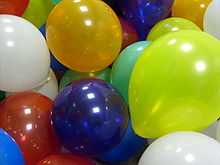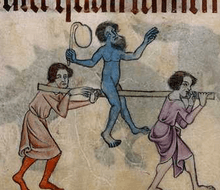Toy balloon

A toy balloon is a small balloon mostly used for child play, party decoration, and advertising.
Toy balloons are usually made of rubber or aluminized plastic, and inflated with air or helium. They come in a great variety of sizes and shapes, but are most commonly 10 to 30 centimetres in diameter.
Toy balloons are not considered to include "sky lanterns" (hot-air paper balloons), although these too are or were used as child toys in some parts of the world.
History


Early balloons were made from pig bladders and animal intestines.[1][2] The Aztecs created the first balloon sculptures using cat intestines, which were then presented to the gods as a sacrifice.[3] There are references to balloons made of whale intestine in Swiss Family Robinson (1813) and in Moby Dick (1851).[4]
The first rubber balloons were made by Professor Michael Faraday in 1824 for use in his experiments with hydrogen at the Royal Institution in London. "The caoutchouc is exceedingly elastic", he wrote in the Quarterly Journal of Science the same year. "Bags made of it...have been expanded by having air forced into them, until the caoutchouc was quite transparent, and when expanded by hydrogen they were so light as to form balloons with considerable ascending power...." Faraday made his balloons by cutting round two sheets of rubber laid together and pressing the edges together. The tacky rubber welded automatically, and the inside of the balloon was rubbed with flour to prevent the opposing surfaces joining together.[5]
Toy balloons were introduced by pioneer rubber manufacturer Thomas Hancock the following year in the form of a do-it-yourself kit consisting of a bottle of rubber solution and a condensing syringe. Vulcanized toy balloons, which unlike the earlier kind were unaffected by changes in temperature, were first manufactured by J.G. Ingram of London in 1847 and can be regarded as the prototype of modern toy balloons.[6]
In the 1920s Neil Tillotson designed and produced a latex balloon with a cat's face and ears from a cardboard form which he cut by hand with a pair of scissors. He managed to make his first sale of these balloons with an order of 15 gross to be delivered for the annual Patriots Day Parade on April 19, 1931. The first colored balloons were sold at the 1933-34 Chicago World's Fair.[7]
Foil balloons
Inflatable foil balloons are made from plastics, such as aluminized PET film. Foil balloons are not elastic like rubber balloons, so that detailed and colorful pictures printed on their surfaces are not distorted when the balloon is inflated. Foil balloons are thus named because they sometimes have a metallic coating to make them shiny, however there have been concerns about metallic balloons causing short circuits when caught in overhead power lines . Because metallic balloons can cause power outages , it is recommended that the metallic balloons not only be tied by a string or ribbon with no metal in it, but also securely tied down by a weight to prevent the balloon from floating away. When no longer required, it is recommended to cut the balloon to release the helium and dispose of in a garbage container.
Filling
Every toy balloon has an opening through which gases are blown into it. Balloons are usually filled by using one's breath, a pump, or a pressurized gas tank. The opening can then be tied off or clamped. Foil balloons are typically self-sealing. By filling a balloon with a gas lighter than air, such as helium, the balloon can be made to float. Helium is the preferred gas for floating balloons, because it is inert and will not catch fire (like hydrogen) or cause toxic effects when inhaled. Small, light objects (postcards, in balloon mail for example) are sometimes placed in balloons along with helium and released into the air and, when the balloon eventually falls, the object inside might be found by another person. Rubber balloons can also be filled with liquids (usually water) and can burst when they impact a solid object. Liquid-filled balloons are commonly referred to as water balloons or water bombs and used in playful fights, and sometimes vandalism.
Balloon shapes
Most toy balloons are a simple oval-like shape. But balloon suppliers also offers other shapes for toy balloons. Some examples of other shapes are: "zeppelins" or "airships," where balloons are usually longer than wide; "espirals" or "rattlesnakes," similar to zeppelins, but much longer (not to be confused with balloons for twisting); "hearts," balloons with the shape of a heart; "dolls," two round shapes joined that represent a head and a body; "mouseheads," composed of three round parts, one for the head and two for the ears; "bunnyheads," similar to mouseheads but with long ears; "bunny balloons," which resemble a stuffed toy bunny, having a big long shape for the body, a smaller shape for the head, and two long shapes for the ears; "elephants," with two shapes for the body and the head, and a very long shape for the trunk; and "ducks," with a big shape for the body, a smaller round shape for the head and smaller shape for the beak. There are many other possible shapes, depending on the manufacturers.
Balloon modeling
There are balloons that are longer and more cylindrical. These long balloons are often twisted and bent into simple, or intricate shapes which will hold their form when released. Balloon artists are people who quickly twist balloons into familiar or abstract shapes using the techniques of balloon modelling, usually for profit.
Uses
Toy balloons are used as decorations and/or advertising space. Balloons are usually purchased in deflated form, however some party stores and vendors at special events will fill their balloons before selling them, this is called "balloon stuffing" where the balloons are filled with objects such as smaller balloons, teddy bears, etc.
While toy balloons are primarily a toy, they are also sometimes used for demonstrations and experiments in classrooms.
See also
| Wikimedia Commons has media related to Toy balloon. |
- Balloon animal
- Balloon modelling
- Balloon release
- Balloon rocket
- List of inflatable manufactured goods
References
- ↑ All you need to know about balloons
- ↑ Rubber Balloon Evolution
- ↑ Jean Merlin, Kaufman and Greenberg, Great Balloons! The Complete Book of Balloon Sculpting, 1994.
- ↑ The History of Balloons
- ↑ Mechanics' Magazine and Journal of Science, Arts, and Manufactures, Vol. 2, Knight and Lacey, 1824; p. 327
- ↑ Patrick Robertson, The Book of Firsts, Bramhall House, NY, 1978.
- ↑ Arnold E. Grummer, The Great Balloon Game Book and More Balloon Activities, Greg Markim, Inc., Appleton, Wisconsin, 1987 ISBN 0-938251-00-7
"How balloons are made". Balloon HQ. Retrieved 22 September 2009.
"Balloon modelling: Twisting balloons". Balloon HQ. Retrieved 22 September 2009.